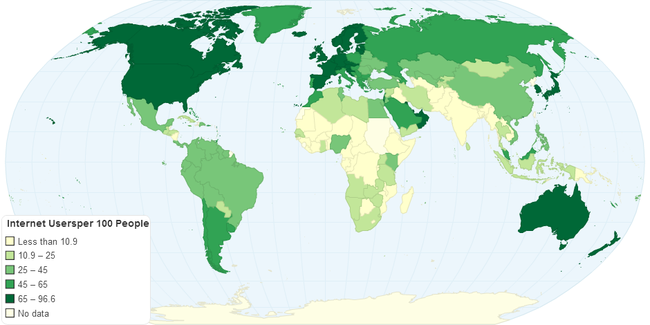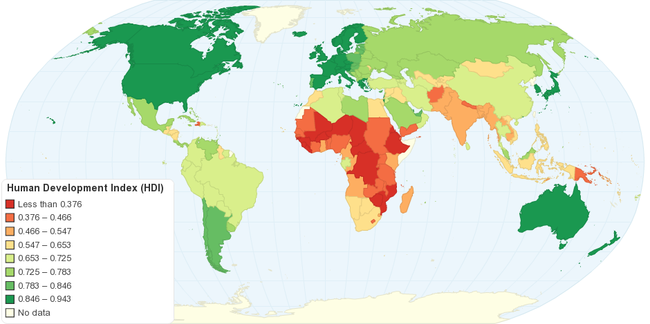Evolution of ICT for Development
Here you will find definitions of key aspects of the ICT4D field.
Definitions
This movie gives you an impression what ICT for development is and intends.
What is “ICT4D”?
ICT4D stands for Information and Communication Technology for Development.
Information and communication technology includes any communication device (radio, TV, PC, mobile phone etc.).
A flat world and the “digital divide”
Today’s
world is thought to be flat. The term “flat world” was first used by T. Friedman.
He states in his book that technological
advances made the world a flat global playing field where all competitors have
an equal opportunity (O'Neal 2006). What do you think? Have a look on the following statistic and the map and answer then this question.
In 2012, 35,6 per 100 people had access to the Internet (The World Bank 2012a). Meaning that 64,4% of the world population are not connected to the world wide web.
On this map, countries with more than 65 Internet users per 100 people are dark green coloured. Countries with less than 10 Internet users per 100 people are pale yellow coloured.

What do you think? Is the world flat or are there valleys, peaks or even a divide? Richard Florida (2005) wrote an interesting article about a “spiky” world. He is especially concerned about future effects of the contrasts between rural (the valleys) and urban (the peaks) areas.
Managing the disparities between peaks and valleys worldwide - raising the valleys without shearing off the peaks - will be among the top political challenges of the coming decades. (Florida 2005)
ICT4D projects aim at bridging the “digital divide“. They intend to help poor people, people in developing countries, around the world to gain access to communication and information. Tomorrows world will be more and more digital. This means that people not “connected" will not be able to competite with the same opportunities as “connected” people.
For development?
Economic and human development is fostered by ensuring access to communications technology. The World Bank states: ‘information technology (IT) service industries have become another engine of job creation - especially for youth and women - and promoted trade and competitiveness through exports’ (The World Bank Group 2011).
How is development measured? What is a developing country?
People in developing countries have generally a low living standard relative to other countries. That is, 82,4% of the population in Rwanda is living on less than two US dollars a day (The World Bank 2012b).
Different indices are used to measure development. There is for instance the Human Development Index (HDI) value. This is a composite index measuring average achievement in three basic dimensions of human development: a healthy and long life, knowledge and a decent standard of living. Developing countries have a low HDI.
On this map, countries with a very low HDI are dark red coloured while countries with a high HDI are coloured in green.

Another indicator for development is the gross domestic product (GDP) of a country. In developing countries this value is low too (Wikipedia 2013a).
Scientifically, at the core of the idea of development stands the enrichment of persons’ capabilities to allow them to be the authors of their own lives within the social group they belong to (Díaz Andrade & Urquhart 2012). The principal outcome of development is choice (Kleine 2010).
The whole spectrum of development using the capabilities approach includes the ability to do business freely in a transparent environment, to have access to education and health services, to be protected from deprivation by welfare state provisions and to voice political opinions freely (Díaz Andrade & Urquhart 2012).
To expand the focus on income as a measurement
of poverty, a concept of the ‘3D human wellbeing’ is proposed. This approach
takes into account what a person owns, what she can do with what she has and
how she thinks about the first two points (Institute of Development Studies 2009). It combines objectively measurable
indicators of human wellbeing (e.g. increase of income, governance reform) with
subjective aspects of wellbeing.
Why?
ICT4D can foster socio-economic development. There are moral reasons why people in wealthier parts of the world should be interested in developmental aid.
ICT4D therefore has a ... moral agenda. It is not primarily about the technologies themselves, but is instead concerned with how they can be used to enable the empowerment of poor and marginalised communities. (Heeks 2009)
Another reason is globalization: problems of developing countries can soon expand to wider parts of the world. ‘Conversely, as the poor get richer, they buy more of the goods and services that industrialised countries produce, ensuring a benefit to all from poverty reduction.’ (Heeks 2009)